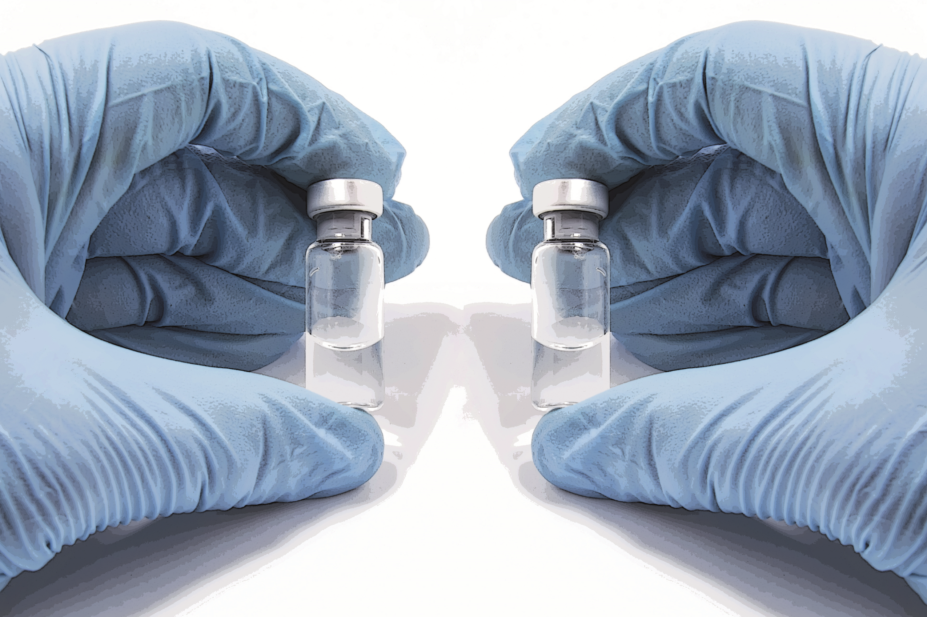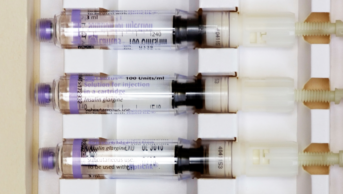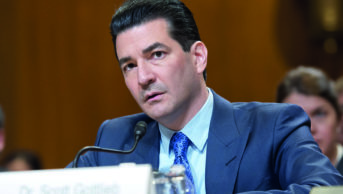
Shutterstock.com
Biosimilar drugs — biologics designed to mimic an original product — continue to generate headlines on their potential for major cost savings. An audit recently reported in The BMJ
[1]
suggested that if all patients being treated with a monoclonal antibody received biosimilars, the NHS would save £3m a year – and with the same outcomes. The audit, conducted by the Royal College of Physicians (RCP)[2]
, found that infliximab biosimiliar drugs were equally effective and safe compared with patented infliximab.
These data add to a bank of information on biosimilars, including an analysis published in the Annals of Internal Medicine
[3]
, which considered 19 eligible studies that compared pharmacokinetics, clinical efficacy, adverse events or immunogenicity of a biosimilar tumour necrosis factor-alpha (TNF-α) inhibitor with a reference biologic in humans. The researchers concluded that preliminary evidence supports the biosimilarity and interchangeability of biosimilar and reference TNF-α inhibitors, and their findings generated widespread press coverage, with pieces in Kaiser Health News[4]
, STAT News[5]
, Consumer Healthday[6]
, United Press International (UPI[7]
) and the International Business Times[8]
. The lead author, Caleb Alexander, told UPI that his study addresses a “billion dollar question” on the similarity of biosimilars and, “based on the available evidence”, he reasoned that the products studied “appeared comparable and they will definitely be cheaper”[7]
.
No legal interchangeability
Despite Alexander’s conclusions, US regulators are struggling with the issue of interchangeability of biologics and biosimilars, on which the US Food and Drug Administration (FDA) has been accused of failing to provide sufficient guidance[9]
. Pfizer’s Inflectra (infliximab-dyyb), for example, is biosimilar to Remicade (infliximab), but it is not considered an “interchangeable” product, so, in some US states, pharmacists will not be able to switch patients from Remicade to Inflectra. The cost saving potential of biosimilars is yet to be realised, and this lack of interchangeability is responsible[10]
.
Drug coverage is more politically natured in the United States than in most other developed countries owing to the power of the drug lobby, which spends considerable resources influencing national and state legislators and regulators. Efforts to advance the use of biosimilars and support the emerging biosimilar industry have been more successful in the EU, where the drug lobby is more restrained – biosimilars already on the market in Europe are estimated to be between 10% and 70% cheaper than their brand name counterparts[4]
.
Interchangeability of biosimilars could have a big impact on drug budgets around the world. According to health economist Austin Frakt[11]
, TNF-α inhibitor biologics such as Remicade or Enbrel – prescribed to treat rheumatoid arthritis, Crohn’s disease, psoriasis and a range of other autoimmune disorders – account for around one-fifth of all drug spending in the United States. The RCP’s report[2]
estimates that if biosimilars were used in the UK instead of patented counterparts, the cost of treating irritable bowel disease could drop by 50%.
Global perspectives
The international biologics market may face turmoil if the drugs are deemed interchangeable while companies and payers adapt to saving tens of millions in annual drug budgets. The growing global expenditure on biologics is predicted to reach US$221bn in 2017[12]
, and an estimated US$71bn in patented biologics will see their patents expire by 2020[13]
— these trends fuel the race to produce biosimilar products to sell at a discount and capture the market.
Interest is growing, but attitudes to biosimilars are different across the world. In the UK, according to NHS England: “The automatic substitution, defined here as the practice of dispensing one medicine instead of another equivalent and interchangeable medicine at the pharmacy level without consulting the prescriber, is not appropriate for biological medicines, including biosimilar medicines and is not permitted at this time[14]
.”
In the EU, there has been a pathway for approving biosimilar medicines since 2003. The main part of the process is comparing the biosimilar with its reference medicine to show that there are no significant differences between them. The European Medicines Agency does not make recommendations on whether a biosimilar can be used interchangeably with its reference medicine, but it suggests that “for questions related to switching from one biological medicine to another, patients should speak to their doctor and pharmacist”[15]
.
Canada’s public health department Health Canada says it does not support automatically substituting biosimilars for brand-name biologics. Coverage decisions are made at the provincial level, but it is unknown whether provinces will make different decisions on substitution[16]
. Australia’s Pharmaceutical Benefits Advisory Committee, however, recommends that biosimilars are suitable for substitution at the pharmacy level[17]
.
Protecting biologic market share
Insurers are among those most interested in the introduction of biosimilars, and while they encourage their use to control prices, drug companies (such as Amgen[18]
) are, according to one analysis[19]
, “hedging their bets by crafting defensive strategies to protect sales of branded biologic drugs while also developing biosimilars of their own”.
Motives to protect the market share of brand-name biologics are controversial, but, suffice to say, opponents have made many other arguments against the introduction and coverage of biosimilars. Below are the main, often unsupported, criticisms hoped to slow down or derail the use of biosimilar products.
- The science isn’t robust yet. Protectors of originator biologics often argue that the biosimilar manufacturers use science that is not as “robust”, employ lower-quality manufacturing standards, and produce products that cause more adverse effects. Some say that biosimilars are not as effective, nor as safe, as the branded drug they have been copied from, although this criticism is unjustified. Some consumers (and prescribers) still doubt the value of brand-name versus generic drugs – an issue being recycled for the biosimilar debate.
- Variations are problematic. The US Biotechnology Innovation Organization says there are interchangeability issues with biosimilars. Its website states: “each individual biologic therapy is a complex, heterogeneous mixture, which, in many cases, cannot be well characterised by current science. Because of this complexity, even minor differences in manufacturing processes can cause variations in the end product[20]
.” But do these variations, if they exist, make any substantive difference to the health outcomes of the patient? Current research suggests that if there are variations, they are not a problem[21]
.
- The regulators must differentiate distinctions between reference product, biosimilar and interchangeable. Some groups argue that there should be no substitution unless the FDA has designated a biologic product as interchangeable, a factor that will delay introduction of many biologics. Opponents typically reason that “interchangeability” is about patient safety. The US FDA[21]
, however, makes the distinctions clear: “There are two new types of biological products: biosimilar and interchangeable. Biosimilars are a type of biological product that are licensed (approved) by the FDA because they are highly similar to an already FDA-approved biological product, known as the biological reference product (reference product), and have been shown to have no clinically meaningful differences from the reference product.” A biosimilar is distinguished from an “interchangeable biological product”, which the FDA says “is expected to produce the same clinical result as the reference product in any given patient,” as well as “meeting the biosimilarity standard”.
- The regulatory regimens must change to deal effectively with safety. Again, the Biotechnology Innovation Organization argues that the US FDA approves biologics on the basis of an “interchangeable status”, and it is state, not federal law, that governs whether one can be substituted by the other. Defenders of originator biologics argue that “in considering patient safety and pharmacovigilance monitoring, current state rules on substitution will likely need to be updated or completely re-written in the context of biosimilar and interchangeable biologic medicines”. This means more delay, more expense for health systems and more US patients unable to afford any biologic product.
- It should be doctors, not payers, who decide which type of product a patient is given. This argument keeps the prescribing physician, who can be “educated” by biologic companies, in charge of any substitutions. This argument preys on the “doctor knows best” rule, and assumes the prescriber knows more about the products’ differences and designates the product he or she believes the patient should receive. Essentially, biologic defenders want doctors to instruct “dispense as written” or “brand medically necessary”, despite the unlikelihood of an underlying reason to justify these directions. This behaviour is already displayed by brand-name companies, which use their large marketing budgets to sway physicians and discredit the generic competition.
- Consumers are ill-informed. Another argument suggests that consumers are uninformed about biosimilars and are easily exploited. A 2015 PWC survey
[18]
found that most consumers could not choose the correct definition of a biologic from a shortlist, but this lack of knowledge is not an acceptable reason for restricting the availability of cheaper biosimilars.
Delaying tactics
Under the guise of “patient protection”, the drug lobby uses an array of arguments to delay the introduction of biosimilars to the US market[22]
. One argument suggests that the prescribing physician should be notified of the substitution because patients may react differently to different products. This argument claims that it is in the interest of public health for the physician to be informed which product is used, so adverse events can be attributed correctly. But this principle applies to all pharmaceuticals.
Second, the lobby argues that the patient, or the patient’s authorised representative, should, at a minimum, be notified of the substitution. This argument calls for heightened vigilance by patients, who should know exactly which product is being administered to discuss with the pharmacist or physician past treatment experiences so that any potential future problems can be avoided. Again, this is no different from other pharmaceutical prescribing in the context of good primary care.
Third, the pharmacist and the physician should keep records of the substitution. This argument states: many biologic medicines are used to treat chronic conditions that can change over time, so it is important for a patient’s treatment team to have records that document how and when a patient was treated with biologic therapies. These records will also provide insight down the road should an adverse reaction or disease evolution occur. Needless to say, proper record-keeping of patients’ medicines is already an essential part of modern medical care, so why bother with extra forms of medical record-keeping for these drugs?
Poor excuses
Pharma and the drug lobby are weak in their efforts to discredit biosimilars and imply lower levels of safety and tolerability compared with their originator products. Research suggests no substantive outcome differences between the use of originator biologics and their biosimilar counterparts, and arguments against their effectiveness and safety fall flat.
References
[1] White C. Infliximab biosimilars are safe, effective, and cheap, UK audit shows BMJ [Internet] 2016 Sept. 22; 354 doi: http://dx.doi.org/10.1136/bmj.i5084. Available at: http://www.bmj.com/content/354/bmj.i5084?utm_medium=email&utm_campaign_name=201609267&utm_source=etoc_weekly (accessed December 2016)
[2] Royal College of Physicians IBD Programme. National clinical audit of biological therapies: UK inflammatory bowel disease (IBD) audit—annual report. September 2016. Available at: https://www.rcplondon.ac.uk/projects/outputs/national-clinical-audit-biological-therapies-annual-report-2016 (accessed December 2016)
[3] Chingcuanco F, Segal JB, Kim SC. Bioequivalence of biosimilar tumour necrosis factor-α inhibitors compared with their reference biologics: a systematic review. Ann Intern Med. 2016;165(8):565-574. doi: 10.7326/M16-0428
[4] Lupkin S. Study bodes well for biosimilars but highlights need for more research. Kaiser Health News. 1 August 2016. Available at: http://khn.org/news/study-bodes-well-for-biosimilars-but-highlights-need-for-more/ (accessed 29 November 2016)
[5] Silverman E. Some biosimilars are just as good as some pricey biologics. STAT News. 1 August 2016. Available at: https://www.statnews.com/pharmalot/2016/08/01/biosimilars-biologics-amgen-abbvie/ (accessed 29 November 2016)
[6] Generic biologic drugs seem as effective as originals. Consumer Healthday 1 August 2016. Available at: https://consumer.healthday.com/general-health-information-16/biosimilar-drugs-961/generic-biologic-drugs-seem-as-effective-as-originals-713338.html (accessed 29 November 2016)
[7] Feller S. Generic biologic drug comparable to brand name version, study says. UPI 2 August 2016. Available at: http://www.upi.com/Health_News/2016/08/02/Generic-biologic-drug-comparable-to-brand-name-version-study-says/5931470141813/ (accessed 29 November 2016)
[8] Marcin T. Generic drugs vs brand name: Johns Hopkins researchers’ biologic study looked at cheaper options. International Business Times. 2 August 2016. Available at: http://www.ibtimes.com/generic-drugs-vs-brand-name-johns-hopkins-researchers-biologic-study-looked-cheaper-2397048 (accessed 29 November 2016)
[9] Brennen Z. Drugmakers split on whether to include interchangeability statement in biosimilar labels. Regulatory Affairs Professional Society 3 August 2016. Available at:http://raps.org/Regulatory-Focus/News/2016/08/03/25512/Drugmakers-Split-on-Whether-to-Include-Interchangeability-Statement-in-Biosimilar-Labels/ (accessed 29 November 2016)
[10] Breenen Z. FDA Approves Second Biosimilar, First mAb Biosimilar for US Market. Regulatory Affairs Professional Society. 5 April 2016. Available at: http://raps.org/Regulatory-Focus/News/2016/04/05/24705/FDA-Approves-Second-Biosimilar-First-mAb-Biosimilar-for-US-Market/# (accessed 1 December 2016)
[11] Frakt A. How to Decrease Prices for an Expensive Class of Drugs. New York Times. 16 November 2016. Available at: http://www.nytimes.com/2015/11/17/upshot/how-to-decrease-prices-for-an-expensive-class-of-drugs.html (accessed December 2016)
[12] IMS Health. A growing share of all medicines are biologic, with biosimilars and non-original biologic (NOB) products now taking a small share of the total market. Available at: https://www.imshealth.com/files/web/IMSH%20Institute/Reports/The_Global_Use_of_Medicines_2017/global%20use%20of%20med%202017%20right6%20Biologics_Market.pdf (accessed 1 December 2016)
[13] Long D. The business of biosimilars. Available at: https://www.healthcaredistribution.org/~/media/pdfs/education/2015-dmc-presentations/tue-f3-biosimilars-biz.ashx?la=en (accessed 1 December 2016)
[14] NHS England. Medical directorate: what is a biosimilar? 24 September 2015. Available at: https://www.england.nhs.uk/wp-content/uploads/2015/09/biosimilar-guide.pdf (accessed 29 November 2016)
[15] European Medicines Agency, Questions and answers on biosimilar medicines (similar biological medicinal products) EMA/837805/2011. 27 September 2012. Available at: http://www.ema.europa.eu/docs/en_GB/document_library/Medicine_QA/2009/12/WC500020062.pdf (accessed December 2016)
[16] Milne V, Laupacis A, Tierney M. Regulators grapple with Canada’s first generic biologic drug, Healthy Debate. 8 January 2015. Available at: http://healthydebate.ca/2015/01/topic/seb-biosimilar-biologics (accessed December 2016)
[17] Generics and Biosimilars Initiative. Australia’s PBAC recommends substitution of biosimilars. 19 June 2015. Available at: http://www.gabionline.net/Biosimilars/General/Australia-s-PBAC-recommends-substitution-of-biosimilars (accessed 1 December 2016)
[18] Amgen Biologics. Biosimilars versus generics. Available at: http://www.amgenbiosimilars.com/the-basics/biosimilars-versus-generics/ (accessed 1 December 2016)
[19] PWC. HRI’s top ten health industry issues of 2016. Available at: http://www.pwc.com/us/en/health-industries/top-health-industry-issues/biosimilars.html (accessed 1 December 2016)
[20] Biotechnology Innovation Organization. BIO principles on patient safety in the substitution of biologic products. Available at: https://www.bio.org/advocacy/letters/bio-principles-patient-safety-substitution-biologic-products (accessed 1 December 2016)
[21] Wechsler J. Does Interchangeability Really Matter for Biosimilars? 9 November 2015 Available at: http://www.pharmexec.com/does-interchangeability-really-matter-biosimilars-0 (accessed 7 December 2016)
[22] US Food and Drug Administration. Biosimilars: information to consumers. Available at: http://www.fda.gov/Drugs/DevelopmentApprovalProcess/HowDrugsareDevelopedandApproved/ApprovalApplications/TherapeuticBiologicApplications/Biosimilars/ucm241718.htm (accessed 1 December 2016)


